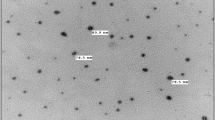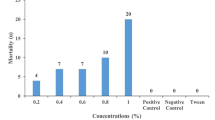Abstract
Purpose
Ticks infestation has a negative impact against human and animal health through blood sucking, transmission of blood-borne diseases and also caused economic losses.
Methods
In the present study the adulticidal, ovicidal and larvicidal activity of d-limonene nanoemulsion (DLN) were evaluated against two tick species; Rhipicephalus annulatus and Rhipicephalus sanguineus. Nanoemulsion form of d-limonene was prepared, and its characteristics were evaluated using a UV spectrophotometer and zeta droplet size measurement. Acetylcholinesterase activity was determined.
Results
The results revealed significant adulticidal effect with low LC50 and LC90 for d-limonene pure form (DL) against both adult tick spp. (R. annulatus and R. sanguineus) ((0.958 and 1.559%) and (2.26 and 3.51%), respectively). DLN LC50 and LC90 values were ((1.277 and 2.396) and (3.97 and 7.28), respectively) against R. annulatus and R. sanguineus, respectively. DL and DLN showed significant ovicidal effect against R. sanguineus at high concentrations (10 and 5%). In larval packet test, LC50 and LC90 values of DL were ((1.53 and 2.22%) and (6.81 and 12.07%), respectively) against R. annulatus and R. sanguineus, respectively, while LC50 and LC90 values of DLN were ((6.48 and 11.26%) and (7.82 and 13.59%), respectively) against R. annulatus and R. sanguineus, respectively. Significant acetylcholinesterase inhibition percentage was detected for both ticks spp. which treated by DL and DLN.
Conclusion
Pure DL is more effective than DLN form against R. annulatus and R. sanguineus.


Similar content being viewed by others
Data Availability
All relevant data are within the paper.
References
Aboelhadid SM, Arafa WM, Mahrous LN, Fahmy MM, Kamel AA (2018) Molecular detection of Rhipicephalus (Boophilus) annulatus resistance against deltamethrin in middle Egypt. Vet Parasitol Reg Stud Rep. 13:198–204. https://doi.org/10.1016/j.vprsr.2018.06.008
Araújo AC, Silveira JAG, Azevedo SS, Bastos FAN, Ribeiro MFB, Labruna MB, Horta MC (2015) Babesia canis vogeli infection in dogs and ticks in the semiarid region of Pernambuco. Brazil Pesq Vet Bras 35:456–461. https://doi.org/10.1590/S0100-736X2015000500012
Dantas-Torres F, Domenico O (2015) Further thoughts on the taxonomy and vector role of Rhipicephalus sanguineus group ticks. Vet Parasitol 208:9–132. https://doi.org/10.1016/j.vetpar.2014.12.014
Silva AB, Duarte MM, Da Costa CR, De Oliveira SV, Vizzoni VF, De Lima Duré AÍ, De Melo Iani FC, Machado-Ferreira E, Gazêta GS (2017) Rickettsia rickettsii infecting Rhipicephalus sanguineus sensu lato (Latreille 1806), in high altitude Atlantic Forest fragments, Ceara State. Brazil Acta Trop 173:30–33. https://doi.org/10.1016/j.actatropica.2017.05.018
Bhanu S, Archana S, Ajay K, Bhatt JL, Bajpai SP, Singh PS, Vandana B (2011) Impact of deltamethrin on environment, use as an insecticide and its bacterial degradation-a preliminary study. Int J Environ Sci 1(5):977. https://doi.org/10.6088/ijessi.0010520027
El-Ashram S, Aboelhadid SM, Kamel AA, Mahrous LN, Fahmy MM (2019) First report of cattle tick Rhipicephalus (Boophilus) annulatus in Egypt resistant to ivermectin. Insects 10(11):404. https://doi.org/10.3390/insects10110404
Arafa WM, Klafke GM, Tidwell JP, Perez de Leon AA, Esteve-Gassent M (2020) Detection of single nucleotide polymorphism in the para-sodium channel gene of Rhipicephalus annulatus populations from Egypt resistant to deltamethrin. Tick and Tick-Borne Dis. 11:101488. https://doi.org/10.1016/j.ttbdis.2020.101488
Pawar AS, Mali GV, Deshmukh HV (2016) Biodegradation of Deltamethrin by using Indigenous bacteria isolated from contaminated soil. Int. J. Curr. Microbiol. App. Sci. 5(5):258–265. https://doi.org/10.20546/ijcmas.2016.505.028
Bagavan A, Kamaraj C, Elango G, Abduz Zahir A, Abdul RA (2009) Adulticidal and larvicidal efficacy of some medicinal plant extracts against tick, fluke and mosquitoes. Vet Parasitol 166(3–4):286–292. https://doi.org/10.1016/j.vetpar.2009.09.007
Isman MB (2020) Commercial development of plant essential oils and their constituents as active ingredients in bioinsecticides. Phytochem Rev 19:235–241. https://doi.org/10.1007/s11101-019-09653-9
Paranagama P, Adhikari C, Pabeywickrama K, Bandara N (2002) Toxicity and repellent activity of Cymbopogon citratus (D.C.) Stapf. and Murraya koenigii Sprang. against Callosobruchus maculates (F.) (Coleoptera: Bruchidae). Trop Agric Res Exten 5:22–28. http://ir.lib.ruh.ac.lk/xmlui/handle/iruor/12540
Hebeish A, Fouda M, Hamdy IA, El-Sawy SM, Abdel-Mohdy FA (2008) Preparation of durable insect repellent cotton fabric: limonene as insecticide. Carbohydr. Polym. 74:268–273. https://doi.org/10.1016/j.carbpol.2008.02.013
Hieu TT, Kim SI, Kwon HW, Ahn YJ (2010) (2010) Enhanced repellency of binary mixtures of Zanthoxylum piperitum pericarp steam distillate or Zanthoxylum armatum seed oil constituents and Calophyllum inophyllum nut oil and their aerosols to Stomoxys calcitrans. Pest Manag Sci 66(11):1191–1198. https://doi.org/10.1002/ps.1993
Trumble JT (2002) Caveat emptor: safety considerations for natural products used in arthropod control. Am. Entomol. 48:7–13. https://doi.org/10.1093/ae/48.1.7
Direct Chem. 607 d’limonene bug killer. 2001. (http://www.directchem.com/607dlimbugki.html)
Gadelhaq SM, Aboelhadid SM, Abdel-Baki AS, Hassan KM, Arafa WM, Ibrahium SM, Al-Quraishy S, Hassan AO, Abd El-Kareem SG (2022) d-limonene nanoemulsion: lousicidal activity, stability, and effect on the cuticle of Columbicola columbae. Med Vet Entomol 2022:1–13. https://doi.org/10.1111/mve.12607
Gadelhaq SM, Aboelhadid SM, Abdel-Baki AS, Hassan KM, Arafa WM, Ibrahium SM, Al-Quraishy S, Hassan AO, Abd El-Kareem SG (2023) Safety and efficacy of pure and a nanosuspension of d-limonene for controlling pigeon lice. J Med Entomol 60(1):148–158. https://doi.org/10.1093/jme/tjac178
Ferrarini SR, Duarte MO, da Rosa RG, Rolim V, Eifler-Lima VL, von Poser G, Ribeiro VLS (2008) Acaricidal activity of limonene, limonene oxide and β-amino alcohol derivatives on Rhipicephalus (Boophilus) microplus. Vet Parasitol 157(2008):149–153. https://doi.org/10.1016/j.vetpar.2008.07.006
Donsi F, Ferrari G (2016) Essential oil nanoemulsions as antimicrobial agents in food. J Biotechnol 10(233):106–120. https://doi.org/10.1016/j.jbiotec.2016.07.005
Ibrahium SM, Aboelhadid SM, Wahba AA, Farghali AA, Miller RJ, Abdel-Baki AS, Al-Quraishy S (2022) Preparation of geranium oil formulations effective for control of phenotypic resistant cattle tick Rhipicephalus annulatus. Sci Rep 12:11693. https://doi.org/10.1038/s41598-022-14661-5
Theochari I, Giatropoulos A, Papadimitriou V, Karra V, Balatsos G, Papachristos D, Michaelakis A (2020) Physicochemical characteristics of four limonene-based nanoemulsions and their larvicidal properties against two mosquito species, Aedes albopictus and Culex pipiens molestus. Insects 11:740. https://doi.org/10.3390/insects11110740
Estrada-Peña A (2004) Ticks of domestic animals in the Mediterranean region: a guide to identification of species. University of Zaragoza. ISBN: 8-4962141-84
Drummond RO, Ernst SE, Trevino JL, Gladney WJ, Graham OH (1973) Boophilus annulatus and B. microplus: laboratory tests of insecticides. J Econ Entomol. https://doi.org/10.1093/jee/66.1.130
Klafke GM, Thomas DB, Miller RJ, Pérez de León AA (2021) Efficacy of a water-based botanical acaricide formulation applied in portable spray box against the southern cattle tick, Rhipicephalus (Boophilus) microplus (Acari: Ixodidae), infesting cattle. Ticks Tick Borne Dis. 12(4):101721. https://doi.org/10.1016/j.ttbdis.2021.101721
Stone B, Haydock KA (1962) Method for measuring the acaricide-susceptibility of the cattle tick Boophilus microplus (Can.). Bull Entomol Res. 53(3):563–578. https://doi.org/10.1017/S000748530004832X
Leite RC (1988) Boophilus microplus (CANESTRINI, 1887): Susceptibilidade, uso atual e retrospectiva de carrapaticidas em propriedades das regiões fisiogeográficas da baixada do Grande Rio e Rio de Janeiro. Uma abordagem Epidemiológica. PhD Thesis, Universidade Federal Rural do Rio de Janeiro, Brazil, p 119
Chintalchere JM, Dar MA, Pandit RS (2020) Biocontrol efficacy of bay essential oil against housefly, Musca domestica (Diptera:Muscidae). J Basic Appl Zool 81(6):1–12. https://doi.org/10.1186/s41936-020-0138-7
Ellman GL, Courtney KD, Andres VJR, Featherstone RM (1961) A new and rapid colorimetric determination of acetylcholinesterase activity. Biochem Pharmacol 7(2):88–95. https://doi.org/10.1016/0006-2952(61)90145-9
Anderson JA, Coats JR (2011) Acetylcholinesterase inhibition by nootkatone and carvacrol in arthropods. Pestic Biochem Physiol 102(2):124–128. https://doi.org/10.1016/j.pestbp.2011.12.002
Hink WF, Fee BJ (1986) Toxicity of d-limonene, the major component of citrus peel oil, to all life stages of the cat flea, Ctenocephalides felis (Siphonaptera: Pulicidae). J Med Entomol. 23(4):400–4. https://doi.org/10.1093/jmedent/23.4.400
Collart MG, Hink WF (1986) Sublethal effects of d-limonene on the cat flea, Ctenocephalides felis. Entomol. exp. appl. 42:225–229. https://doi.org/10.1111/j.1570-7458.1986.tb01026.x
Mursiti S, Lestari NA, Febriana Z, Rosanti YM, Ningsih TW (2019) The activity of d-limonene from sweet orange peel (Citrus Sinensis L.) exctract as a natural insecticide controller of bedbugs (Cimex cimicidae). Orient J Chem. https://doi.org/10.13005/ojc/350424
Prado-Rebolledo OF, Molina-Ochoa J, Lezama-Gutierrez R, Garcia-Marquez LJ, Minchaca-Lierenas YB, Morales-Barrera E, Guillermo T, Hargis B, Skoda SR, Foster JE (2017) Effect of Metarhizium anisopliae (Ascomycete), cypermethrin, and d-limonene, alone and combined, on larval mortality of Rhipicephalus sanguineus (Acari: Ixodidae). J Med Entomol. https://doi.org/10.1093/jme/tjx092
Brito WA, Siquieroli ACS, Andealó V, Duarte JG, Sousa RMF, Felisbino JKRP, Silva GC (2021) Botanical insecticide formulation with neem oil and d-limonene for coffee borer control. Pesq Agrop Brasileira 56:e02000. https://doi.org/10.1590/S1678-3921.pab2021.v56.02000
El Aalaoui M, El Bouhssini M, Bouharroud R, Sbaghi M (2021) Lethal and sublethal efects of the insecticides d-limonene, mineral oil, and potassium salts of fatty acid on Dactylopius Opuntiae potential predator Cryptolaemus Montrouzieri. Int J Trop Insect Sci 41:2897–2906. https://doi.org/10.1007/s42690-021-00473-z
Showler AT, Harlien JL, de Leon AAP (2019) Effects of laboratory grade limonene and a commercial limonene-based insecticide on Haematobia irritans irritans (Muscidae: Diptera): deterrence, mortality, and reproduction. J Med Entomol 56(4):1064–1070. https://doi.org/10.1093/jme/tjz020
Feng J, Wang R, Chen Z, Zhang S, Yuan S, Cao H, Jafari SM, Yang W (2020) Formulation optimization of d-limonene-loaded nanoemulsions as a natural and efficient biopesticide. Colloids Surf A 596:124746. https://doi.org/10.1016/j.colsurfa.2020.124746
Li P, Lu W (2016) Effects of storage conditions on the physical stability of d-limonene nanoemulsion. Food Hydrocolloids 53(2016):218–224. https://doi.org/10.1016/j.foodhyd.2015.01.031
Funding
This work was supported by Researcher supporting Project [RSP-2023/3], King Saud University.
Author information
Authors and Affiliations
Corresponding author
Ethics declarations
Conflict of Interest
The authors declare that they have no conflict of interest.
Additional information
Publisher's Note
Springer Nature remains neutral with regard to jurisdictional claims in published maps and institutional affiliations.
Rights and permissions
Springer Nature or its licensor (e.g. a society or other partner) holds exclusive rights to this article under a publishing agreement with the author(s) or other rightsholder(s); author self-archiving of the accepted manuscript version of this article is solely governed by the terms of such publishing agreement and applicable law.
About this article
Cite this article
Ibrahium, S.M., Abdel-Baki, AA.S., Al-Quraishy, S. et al. Efficacy of d-Limonene Nanoemulsion Against Rhipicephalus annulatus and Rhipicephalus sanguineus Ticks. Acta Parasit. 69, 267–274 (2024). https://doi.org/10.1007/s11686-023-00734-6
Received:
Accepted:
Published:
Issue Date:
DOI: https://doi.org/10.1007/s11686-023-00734-6




